Washington Post
By Lizette Ortega
5 Aug, 2024
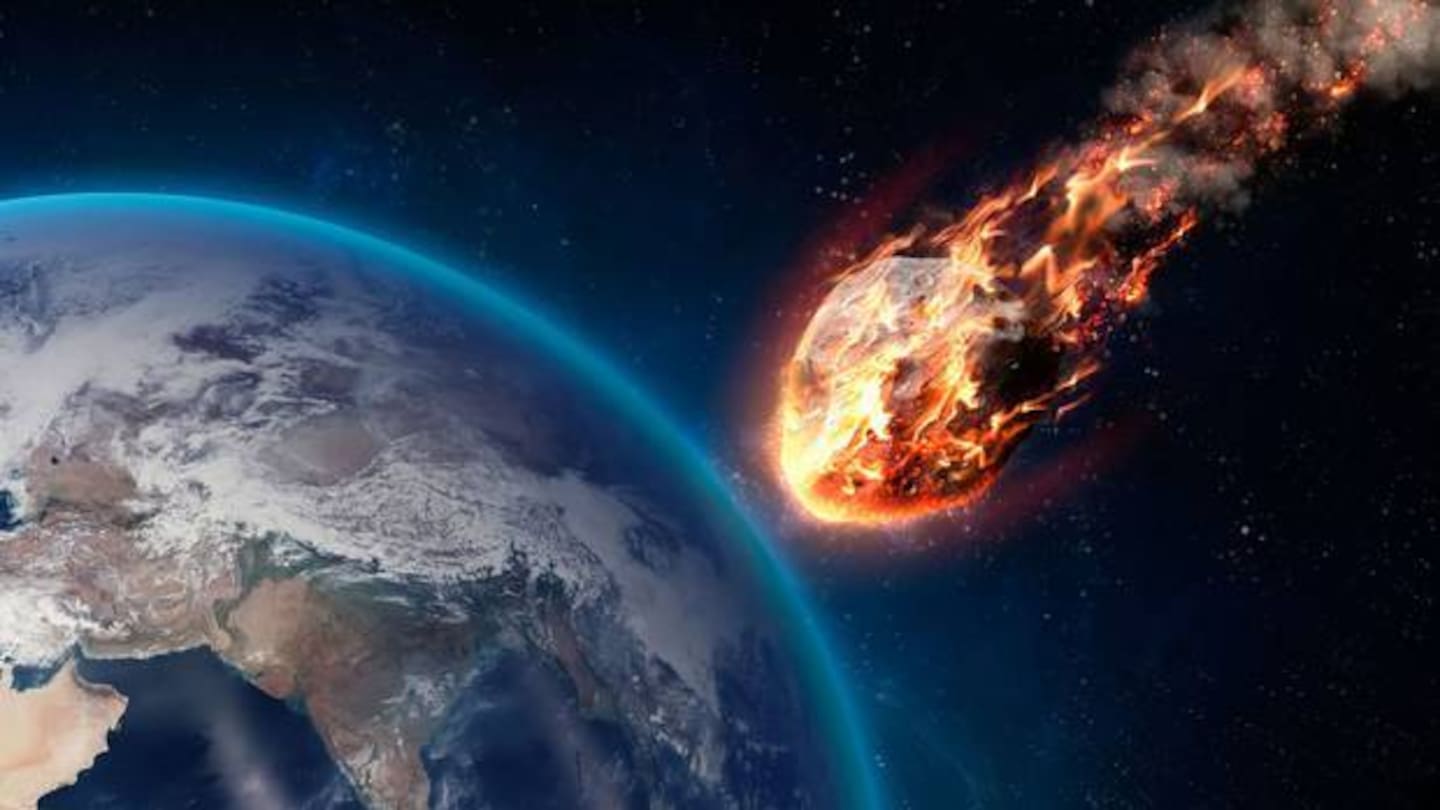
While Apophis (not pictured) might never hit Earth's surface, Neil deGrasse Tyson spoke chillingly about what could happen. Photo / 123RF
A massive space rock will go hurtling past Earth in a few years, zooming by 10 times faster than a bullet.
This is the first time an asteroid of its size is coming close enough that people in parts of Western Europe and Africa will see it soaring across the sky like a fast-moving star, no fancy telescopes or binoculars required. Around 2 billion people will get to witness this rare event.
To be clear, the asteroid is not going to hit Earth - not in our lifetime nor our children’s lifetimes, anyway. Instead, as if the universe was making a joke, the space rock will make an eerily close flyby on Friday the 13th in April 2029.
The asteroid is named Apophis, and it will come closer to Earth than the satellites that make weather monitoring possible and about 10 times closer than the moon.
“Nature is performing this once-per-several-thousand-years experiment for us. We have to figure out how to watch,” said Richard P. Binzel, a professor of planetary science at MIT.
Apophis is a once-in-a-lifetime opportunity to study asteroids like never before. Getting a close-up look at Apophis will help scientists figure out how to protect our planet against an asteroid that wants to throw a punch at Earth in the future.
But missions to space take years to develop and there are less than five years before Apophis makes its close approach to Earth.
“We’re running out of time,” said Jason Kalirai, executive for space formulation at the Johns Hopkins Applied Physics Laboratory.
While the rock - which scientists believe has two lobes - is peacefully minding its business in space, that was not the case when it was discovered in June 2004 by scientists at the Kitt Peak National Observatory. Later that year, researchers calculated a 2.7% chance that the asteroid’s encounter with Earth in 2029 would be a violent collision, not a harmless flyby.
“If it was to encounter a populated area, it could take out a city the size of New York,” said Daniella DellaGiustina, lead scientist on a Nasa mission to Apophis called Osiris-Apex.
Apophis made such a bad first impression on the world that it was named after the Egyptian serpentine god of darkness and chaos.
It was not until March 2021 that scientists were able to rule out an Apophis-Earth collision for at least the next 100 years. Using a 70m-long radio antenna in California, scientists collected the data they needed to clear Apophis’s name and remove it from Nasa’s Sentry Impact Risk Table, a list of asteroids with some chance of affecting Earth in the next century.
Apophis will come within 32,000km of Earth - give or take a few miles. When two objects come close in space, they exert forces on each other. Just like Earth experiences tidal forces generated by the moon, Apophis will feel tidal forces generated by Earth.
While the moon’s gravitational pull causes high tides on Earth, Earth’s gravitational pull might cause mini asteroid quakes on Apophis. Apophis’s flyby will mark the first chance to view seismic activity on an asteroid.
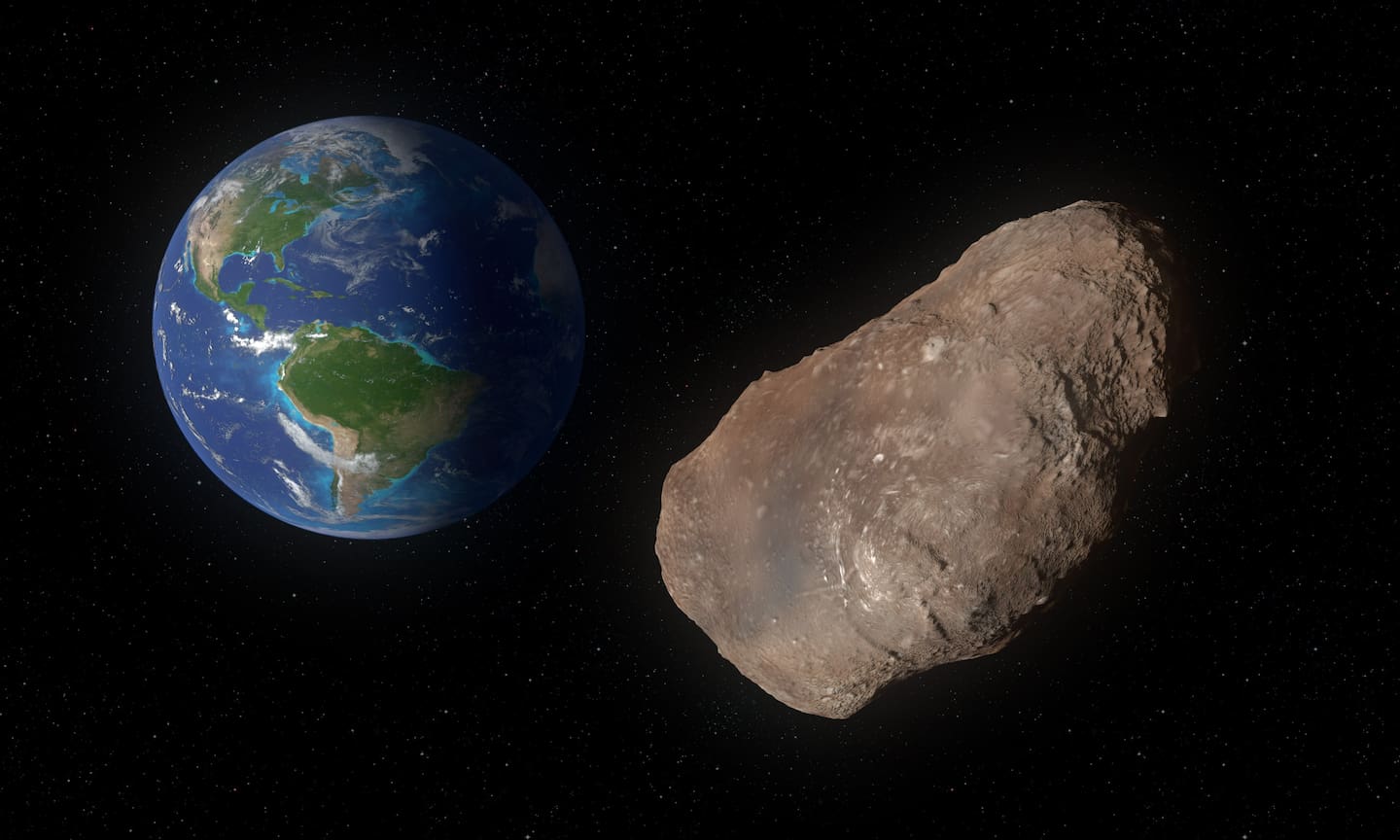
The asteroid space chase
Now that scientists know Apophis will not collide with Earth, they have turned their attention to another problem: how to make it to Apophis in time.
“What are we doing about Apophis? I would say not enough,” Kalirai said.
Though Apophis has been a source of fascination for two decades, no one knows what it actually looks like. Many of its basic properties remain unknown, including its mass and structure.
Recently, Earth’s planetary defense capabilities were put to the test by Nasa’s Double Asteroid Redirection Test, or Dart, in which researchers at Johns Hopkins successfully smashed a spacecraft into an asteroid to change its orbit.
While the researchers are proud of Dart, they emphasised that Earth’s self-defence tool kit is not complete. Planetary defence is not just about throwing celestial upper-cuts. Scientists need to be able to locate asteroids and study their characteristics to mount an effective response.
“Apophis is an opportunity to practice what kinds of characterisation efforts could be done to better understand a particular object. Lessons from that can be applied in the future when we find an asteroid coming our way,” said Terik Daly, a planetary scientist on the Dart and Osiris-Apex missions.
Nasa’s Osiris-Apex mission will redirect an existing spacecraft so that it characterises Apophis after its closest approach to Earth. The mission will study how the asteroid was affected by Earth’s gravity using high-resolution images of Apophis’s surface.
The Osiris-Apex spacecraft can also use its thrusters to kick up dust on the asteroid. With this capability, scientists will learn how strong Apophis’s surface is, which will inform how to deflect it in the future if needed.
If the asteroid has a tough surface that does not break easily, an impact approach like Dart might not be effective in changing the asteroid’s orbit.
A close inspection of asteroids can also help answer long-held questions about the solar system, including where Earth’s water came from. By comparing water on Earth and asteroids, scientists can look for similarities that provide clues about how this important resource arrived on our planet billions of years ago.
But Osiris-Apex cannot stand alone. Since the mission’s spacecraft is already in orbit with limited fuel, it can make it to Apophis only in June, two months after its closest approach to Earth.
If scientists are going to fully understand Apophis and how it was affected by Earth, there need to be missions that study the asteroid before and during its closest approach.
So far, Osiris-Apex is the only confirmed and fully funded mission to Apophis.
‘No bucks, no Bruce Willis’
At Apophis T-5 Years, a two-day workshop to foster international collaboration on Apophis missions, scientists proposed more than 20 spacecraft and payloads combined.
“In an ideal world, we would have a fleet of missions to Apophis,” Kalirai said. But scientists have less than five years to develop, build and launch a mission.
In addition to time, there is a shortage of money to fund missions to Apophis.
“No bucks, no Bruce Willis,” Binzel said.
As a result, many scientists are trying to repurpose old missions to beat the clock and go easy on the wallet.
Experts are urging Nasa to study pre-flyby Apophis with the Janus spacecraft, which were meant to launch in 2023 as part of a separate mission. After delays in that mission, the two spacecraft were put in storage indefinitely.
Scientists at Apophis T-5 Years described a pre-flyby encounter with Apophis as a mission in search of a spacecraft. They believe that need could be met by the Janus satellites, which are spacecraft in search of a mission.
Blue Origin, a private space company founded by Jeff Bezos, reported that its Blue Ring spacecraft could meet Apophis three months before the flyby. The spacecraft has 13 payload slots, allowing the cost of the mission to be shared among multiple parties. (Bezos owns the Washington Post.)
Of all the proposals floating around, a mission developed by the European Space Agency is the closest to fruition. In an act of recycling similar to Osiris-Apex, the ESA’s Rapid Apophis Mission for Space Safety - Ramses - makes use of technology built for the Hera Mission, which is expected to launch this year to study the aftermath of Dart.
Ramses would encounter Apophis two months before its flyby and stay close to watch how it is affected by Earth’s gravity. The mission would monitor how Earth alters Apophis’s rotation, which plays a huge role in what the asteroid’s orbit will look like far into the future.
The Space Safety programme board has given the ESA permission to start working on the mission. However, Ramses is not in the clear yet: the mission awaits final approval for funding by the ESA’s Council of Ministers, who will make their decision at the end of next year.
While there is a near-zero chance Earth will meet an asteroid capable of mass extinction soon, there is a 100% probability that a devastating asteroid will risk striking Earth at some point.
“The question is when and whether we’re able to prevent it before that happens,” said Bruce Betts, chief scientist at the Planetary Society, which advocates for space exploration.
Unlike most natural disasters, asteroid collisions are preventable if tools exist to keep track of space rocks and act in self-defence if needed.
Building out Earth’s planetary defence toolkit is not about fear, according to Binzel. “It’s simply about sensible responsibility.”
Joel Achenbach contributed to this report.
The James Webb Space Telescope has observed stellar outflow that are "all slanted in the same direction, to the same degree, like sleet pouring down during a storm" in the Serpens Nebula, according to ESA/NASA.
Credit: Directed by: Bethany Downer and Nico Bartmann Editing: Nico Bartmann Web and technical support: Enciso Systems Written by: Bethany Downer Music: Stellardrone - Light Years Footage: NASA, ESA, CSA, STScI, K. Pontoppidan (NASA’s Jet Propulsion Laboratory), J. Green (Space Telescope Science Institute)
Jamie Carter
Sun, August 4, 2024
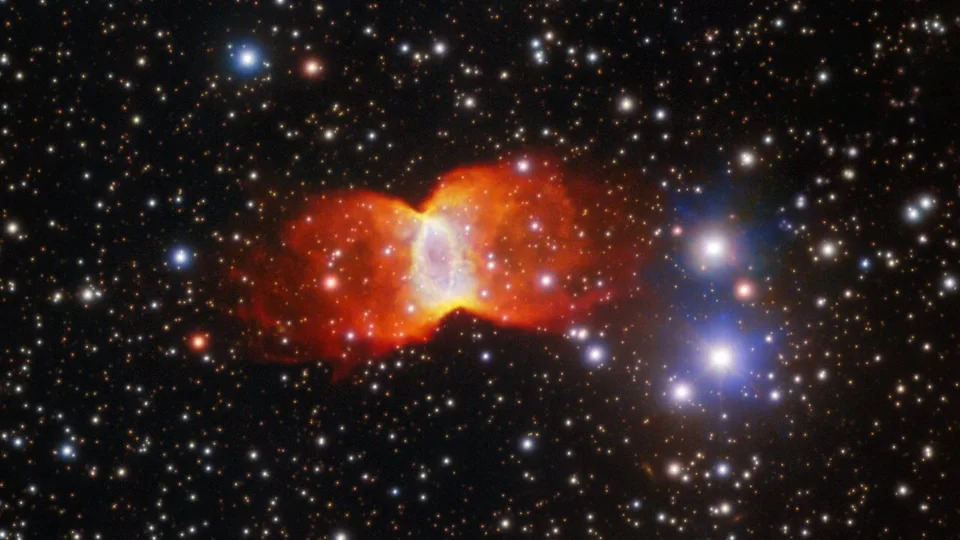
Credit: International Gemini Observatory/NOIRLab/NSF/AURA. Image processing: J. Miller (International Gemini Observatory/NSF's NOIRLab), M. Rodriguez (International Gemini Observatory/NSF's NOIRLab) & M. Zamani (NSF's NOIRLab)
What it is: Kohoutek 3-46, a planetary nebula.
Where it is: 7,200 light-years distant in the constellation Cygnus.
When it was shared: July 24, 2024.
Why it's so special:
Death comes violently for massive stars. As they burn through their fuel and begin to cool, pressure drops and gravity takes control. A core collapse can follow, causing a bright supernova explosion.
However, that's not how all stars end their lives. When a smaller star about one to eight times the size of the sun exhausts its fuel, it expands into a cool red giant star. Eventually, it expels its outer layers of atmosphere. Those layers can glow for thousands of years in beautiful colors and shapes, illuminated by light from the star's leftover core, also called a white dwarf.
Related: Space photo of the week: Ring Nebula glistens like a jelly-filled doughnut in Webb telescope's latest images
That's what's happening at Kohoutek 3-46, whose shape resembles a butterfly. It's estimated to be about 20,000 light-years old and is an unusual example of what astronomers call a planetary nebula. The term is misleading because Kohoutek 3-46 has nothing to do with planets. The name, coined by astronomer William Herschel in the 1700s, describes the rough shape of the object (most are circular) when viewed through a small telescope.
Kohoutek 3-46, however, isn't round but a bipolar hourglass shape, which accounts for only about 10 to 20% of planetary nebulas. It was discovered in 1964 by astronomer Luboš Kohoutek, who discovered 300 planetary nebulas throughout his career.
—Space photo of the week: A cosmic 'ghost' peers through the universe's past
—Space photo of the week: Hubble captures one of our galaxy's oldest objects
—32 jaw-dropping James Webb Space Telescope images
This image was captured by the Gemini North telescope in Hawaii, one half of the Gemini Observatory (the other is Gemini South in Chile's Atacama Desert). The Gemini North telescope is supported in part by the U.S. National Science Foundation (NSF) and operated by NSF NOIRLab.
Kohoutek 3-46 is currently riding high in the Northern Hemisphere's post-sunset night sky. Its constellation, Cygnus, is part of the famous "Summer Triangle" shape of stars (here's how to find it in the sky tonight). Close by is the constellation Lyra, which hosts the famous Ring Nebula (also called M57), a planetary nebula with a more typical shape.
Victor Tangermann
Mon, August 5, 2024
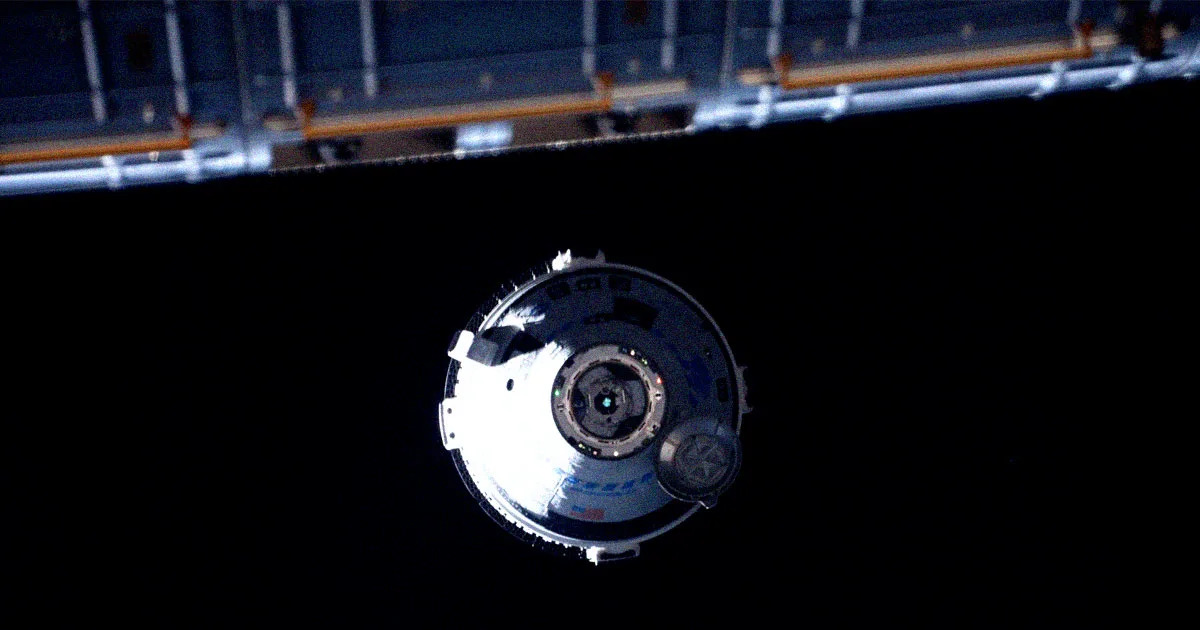
Empty Nester
NASA astronauts Butch Wilmore and Suni Williams have been stranded in space since arriving at the International Space Station on June 6, just shy of two months ago.
Their journey was supposed to last just two weeks, but ongoing technical issues with their ride, Boeing's much-maligned Starliner spacecraft, have delayed their return indefinitely. NASA still hasn't announced a return date.
Now, NASA has been discussing the option of having Starliner return back to the surface with neither Wilmore nor Williams on board, CNBC reports, though finding consensus has been difficult and discussions are still ongoing.
This scenario would involve sending a replacement SpaceX Crew Dragon capsule to rescue the two, NASA's flightworthy workhorse that cost a fraction to develop, despite being a part of the same Commercial Crew program as Starliner.
Sending the capsule back empty would be a major vote of no confidence in Boeing following years of delays, technical issues, and a failed launch attempt — not to mention a PR disaster for both NASA and Boeing, which have been adamant that everything has been going according to plan despite the chaos and delays.
Whether an empty return would seal Starliner's fate remains to be seen. Boeing and NASA have already committed a whopping $6.7 billion to the project since 2010 and are unlikely to give up too easily.
Capsule Culture
Over the last two months, NASA has played down the extent of Boeing's issues, with NASA commercial crew program manager Steve Stich arguing that the two astronauts were "not stranded" during a late June press conference.
Several of the capsule's 28 thrusters failed during docking procedures in early June. While NASA has since claimed that all but one are in good working condition, we still don't know the exact root cause.
The space agency and Boeing have painted their ongoing investigations as a way to collect more data, presumably to quell concerns.
But time is running out. Starliner's batteries are only rated to stay in orbit through early September.
The agency is still "evaluating all options," as Ars Technica reported last week, to get the two astronauts back.
"No decisions have been made and the agency will continue to provide updates on its planning," a NASA spokesperson told Ars.
Considering Boeing has lost a whopping $1.6 billion on Starliner, it shouldn't come as a surprise that NASA is still hemming and hawing before giving up.
But the company remains "confident in the Starliner spacecraft and its ability to return safely with crew," a Boeing spokesperson told CNBC last week
Richard Luscombe in Miami
Sun, August 4, 2024
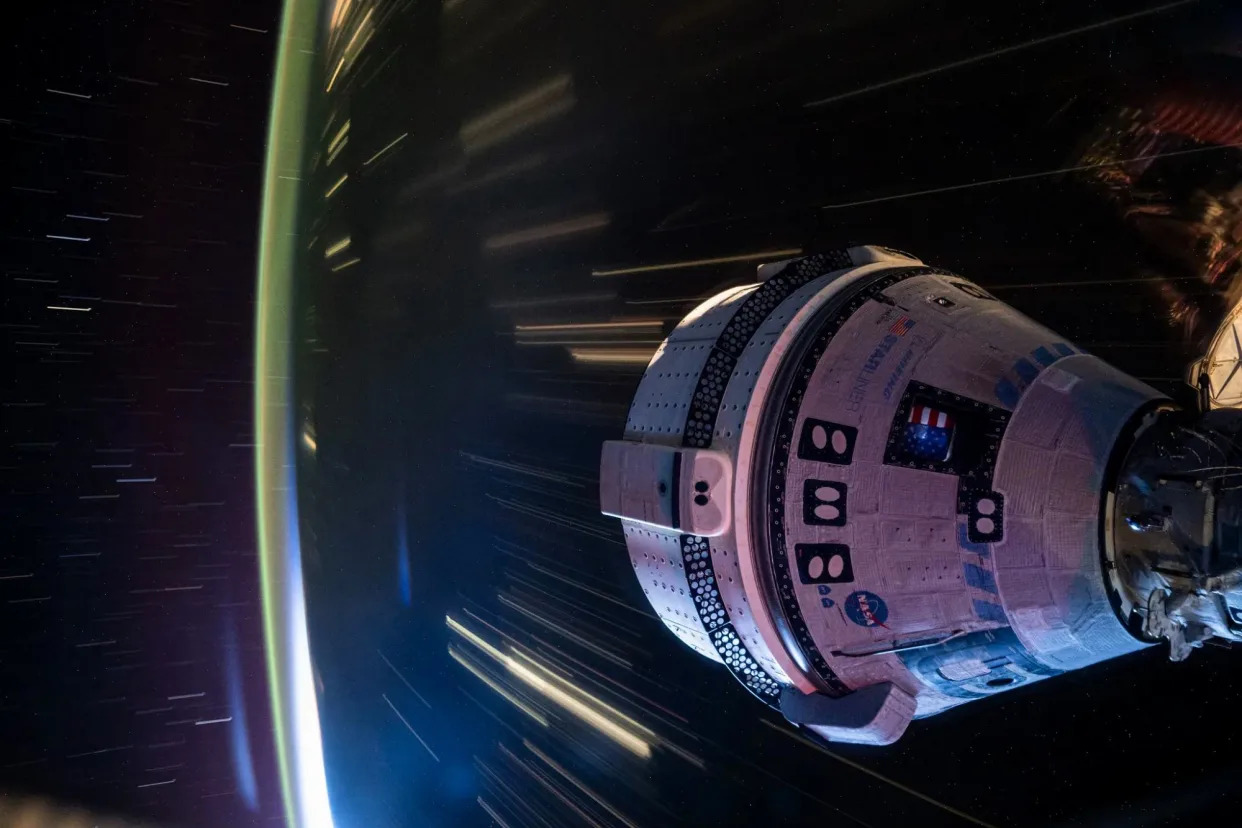
Boeing’s Starliner spacecraft docked to the International Space Station’s Harmony module’s forward port in July 2024.Photograph: Nasa
It should have been a welcome public relations triumph for Boeing, an opportunity to show that even if panels were falling from its aircraft, it could still fly humans into space and return them safely to Earth.
And for a while at least, it looked like it had been successful. The majestic June launch of the much-delayed and over-budget Starliner capsule from Florida, ferrying two Nasa astronauts to the International Space Station, offered a glimpse of a bright new future in the heavens for the troubled aerospace giant.
The euphoria, however, was as fleeting as a shooting star. Technical issues with the pioneering spacecraft mean it is still docked to the orbiting outpost, 59 days into a maiden crewed test mission that was originally expected to take up to 10. And alarming – yet inaccurate – headlines that the astronauts are somehow stranded indefinitely in space, like Matt Damon in the Martian, are proliferating.
Related: Nasa rover discovery hints at ancient microbial life on Mars
The saga represents more of a crisis in communications management than any failure of Starliner, which after all is an experimental vehicle suffering similar teething troubles to any preceding generation of spacecraft, from the mighty Apollo moon rockets of the 1960s to the space shuttle, and last year’s “rapid unscheduled disassembly” of Elon Musk’s futuristic Starship.
Announcements in recent days from Nasa and Boeing, partners in the Starliner project as part of the US space agency’s commercial crew program, suggest a return date for the capsule, and the astronauts Sunita Williams and Butch Wilmore, is finally imminent. Glitchy thrusters that unexpectedly shut down early in the mission performed well in tests, and several small but persistent helium leaks are no longer considered a constraint for undocking.
“The vehicle is in good shape. I want to make it very clear that Butch and Suni are not stranded in space,” Steve Stich, manager of Nasa’s commercial crew program, told a press conference last week.
Yet a sense of unease remains. Media briefings, initially at least, were scarce, leading to suspicion from some reporters that Boeing and Nasa were downplaying the extent of the technical problems, or the likely duration of the astronauts’ stay, given their initial eight-to-10-day mission estimate.
The most recent press conference became tetchy in places as Stich and Mark Nappi, Boeing’s commercial crew program manager, pushed back. The delays, they insisted, were a routine part of spaceflight, engineers were identifying and solving the issues, and all the while the crew and capsule were never in danger.
Additionally, Stich said, Starliner was cleared to leave the space station at any time in the event of an emergency.
Nappi, however, did admit he had inadvertently fueled the “lost in space” narrative.
Asked how he would handle things differently, he said: “We would not have been so emphatic about [it being] an eight-day mission. It’s my regret that we didn’t just say we’re going to stay up there until we get everything done that we want to go do.”
Experts say there is nothing unexpected or unusual about an experimental spaceflight developing problems, or mission managers dedicating time to diagnose and fix them. With Starliner, teams of ground engineers at Nasa’s White Sands facility in New Mexico spent weeks recreating and working through the thruster issues, and Williams and Wilmore boarded the docked capsule last weekend to conduct an in-orbit hot fire test of its propulsion systems.
“It’s defined as a test mission, it’s called a crewed test flight, and one of things is to deal with unplanned issues,” said Jerry Stone, senior associate of the Space Studies Institute and author of One Small Step.
“But the thing to do in a situation like this is not to, I won’t say hide anything because they’re not doing that, but to be much more open, especially with the media, because the media is going to make this out to be as dramatic as possible.”
Stone said it was probably a mistake for Boeing and Nasa to have announced an expected end date for Starliner’s first human mission instead of adopting an “it takes as long as it takes” approach.
“The expected reaction, particularly from the public, is something has gone wrong and they can’t get back. And yes, something has gone wrong. But the statement that they can’t get back is most definitely incorrect.”
Mike Massimino, a retired Nasa astronaut who flew two longer-duration space shuttle missions in 2002 and 2009 to fix the Hubble space telescope, agreed that messaging and perception was more of an issue than solving the technical problems.
“From my perspective as an astronaut engineer, it’s been a successful test flight. You want to wring it out and see what’s going on. There’s no reason to bring the crew back early if they have the supplies, which they do, and the spacecraft is stable. I think this is a good thing, a chance to really work out the kinks.
“[But] because they said it’s going to be between this many days, and this many days, people try to put one and one together. It’s like, all right, so this thing’s longer now, and they have problems, so they’re staying longer because they have problems. And that’s not the case.”
Massimino said Boeing’s fledgling spaceflight troubles would, ultimately, pass quietly into history.
“The first SpaceX launch of the Dragon capsule was delayed by many years too,” he said. “My experience is we don’t remember the delays, but you sure as heck will remember an accident, Challenger, Columbia.
“When things go boom and people are killed, we remember that, the whole country will mourn and so on, and that’s what you want to avoid. This is certainly not an Apollo 13. I’m not saying people won’t remember this, but it’ll be an interesting lesson learned looking back, maybe more so how the communication went.
“They seem to be understanding the problems they have. I have confidence they’re going to understand what those things were, fix them for the next time and get Starliner and the crew back safely.”
2 months after Starliner launched, astronauts still haven’t returned: See timeline
Eric Lagatta, USA TODAY
Mon, August 5, 2024
Just as a slew of obstacles and mishaps delayed the launch of the Boeing Starliner time after time, so too has the return of the spacecraft's astronaut crew been postponed again and again.
It took a team of engineers about a month just to get Boeing's CST-100 Starliner prepared for its trip to the International Space Station after its initial launch date on May 6 was scrubbed at the last minute. When the capsule finally reached orbit June 5 while perched atop an Atlas V rocket built by United Launch Alliance, things were finally looking up for Boeing – in both a literal and figurative sense.
The company had for years sought to prove that its Starliner could compete with the likes of Elon Musk's SpaceX as one of two companies making routine trips to orbit on NASA’s behalf. After its first uncrewed test flight in 2019, June's launch marked a critical milestone as Starliner first flight with astronauts aboard.
NASA astronauts Barry "Butch" Wilmore and Sunita "Suni" Williams were tentatively scheduled to spend little more than a week aboard the International Space Station once their capsule docked on June 6, a day after launching from the Kennedy Space Station in Cape Canaveral, Florida.
But two months after Starliner launched, the pair still remain in orbit at the space station with no return date set.
Here's a look at the major moments of the Boeing Starliner's inaugural crewed mission, including scrubs, launch and return delays.
DART mission: Images from NASA spacecraft reveal insights into near-Earth asteroid
May 6: Starliner launch called off hours of liftoff
Years in the making, the third and final orbital flight test for Starliner was scheduled for launch until it is called off within hours of liftoff when engineers detected an anomaly on the pressure regulation valve in the liquid oxygen tank of the rocket's upper stage, according to NASA. The United Launch Alliance later says in a statement that the cancellation was "out of an abundance of caution for the safety of the flight and pad crew."
Days later, Wilmore and Williams return to Houston to spend extra time with their families as mission engineers work to fix the issues ailing Starliner.
NASA eyes May 17 as a potential mission launch after the United Launch Alliance initially said that the launch would not be able to take place any earlier than May 10. Mission engineers requested the extended delay in order to have time to replace the faulty value, NASA said.
On May 21, the team is able to replace the valve and re-pressurize the system, but then engineers encountered another obstacle: a small helium leak in Starliner's service module. The issue required the launch date to be pushed back once again, this time indefinitely.
June 1: Starliner prepares to launch again, scrubbed again
On June 1, The Starliner appears poised to finally take off. NASA decided to continue with the launch without repairing the helium leak, as the chemical used in spacecraft thruster systems is not combustible or toxic. However, the launch is once again scrubbed, this time minutes before liftoff due to a computer issue, NASA said on X, formerly Twitter.
The crew passes on a possible launch the next day and NASA instead eyes a launch window beginning June 5.
June 5: Starliner finally launches
On June 5, the Starliner, at long last, launches. Boeing Space shares a post on X at 11:44 a.m. confirming Starliner had reached a stable orbit and had broken away from the Atlas V rocket. From there, the craft began firing its own engines as it powered onward to the International Space Station, NASA said.
The following day, the Starliner docks at 1:34 p.m. EDT on the forward-facing port of the International Space Station's Harmony module. However, the night before, NASA shares an update unveiling that two more helium leaks had been discovered on the spacecraft occurring after Starliner arrived in orbit.
June 9: NASA announces astronauts will not return on date originally planned
Though Wilmore and Williams were only slated to spend a week on the space station, NASA announces on X that the Starliner and its two astronauts would likely land in the New Mexico desert no earlier than June 18. The space agency said the additional time at the space station was for the astronauts to assist with a spacewalk and to allow engineers more time to complete system checkouts of Starliner.
June 14: Astronauts return delayed again
The return is delayed a second time, with the astronauts now slated to undock from the International Space Station no earlier than June 25, landing June 26 at the White Sands Space Harbor in New Mexico, Boeing said in an update. While the spacecraft is cleared for crew emergency return scenarios, Boeing said the extra time allows the team to finalize departure planning and operations.
June 21: And again
Boeing and NASA once again delay the return home of Williams and Wilmore until July at the earliest. This time the agencies cite "a series of planned International Space Station spacewalks while allowing mission teams time to review propulsion system data." However, the agencies explain that the astronauts are by no means stranded in space, as supplies on the space station are plentiful and the pair can assist in station operations.
July 10: Astronauts aren't 'complaining' about being in space
Wilmore and Williams appear in a NASA telecast from the International Space Station. During seperate new conferences, Williams says, "I'm not complaining, Butch isn't complaining that we're here for a couple extra weeks." Meanwhile, scientists and engineers work through testing to better understand and resolve problems that occurred during Starliner's launch and flight, including some misfiring thrusters and helium leaks.
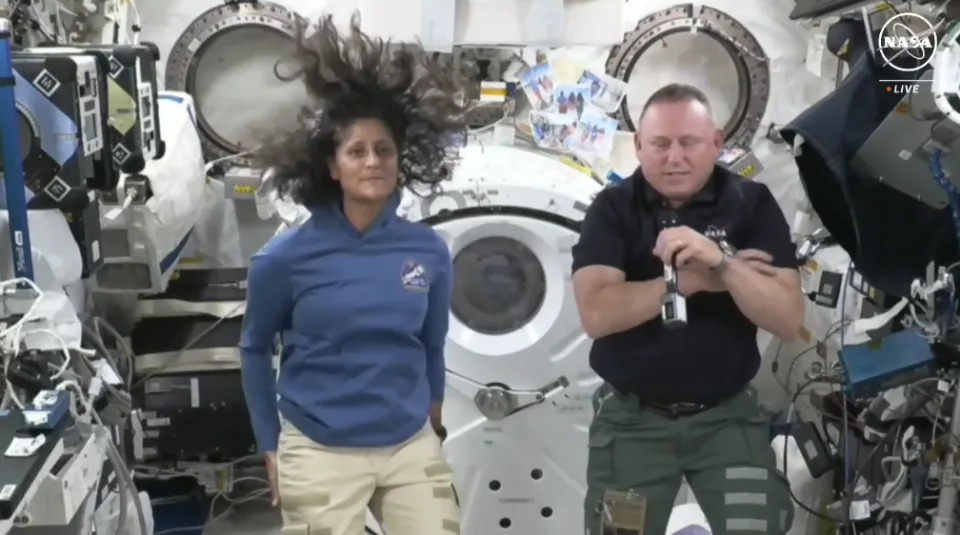
Suni Williams and Butch Wilmore speak to NASA officials during a live streamed event on Monday, June 10.
July 25: NASA, Boeing say there is still no return date
NASA and Boeing say in a press conference that the Starliner still does not yet have an official return date. However, NASA Commercial Crew Program Manager Steve Stich says, "We're making great progress."
Stich also shares that NASA has contingency options for returning Butch and Sunni to Earth, but right now the focus is on finishing up the tasks necessary to do so on Starliner.
August: Astronauts work at ISS while planning for return home
Wilmore and Williams, both Navy test pilots before they joined NASA, were to spend their limited time at the International Space Station testing the Starliner spacecraft and its subsystems.
With their stay indefinitely extended, the astronauts, both of whom had ventured to space twice before, have helped the space station crew with other operations while helping plan a return date when they can, NASA and Boeing have said.
Most recently, NASA and Boeing said engineers completed a hot fire test of the Starliner spacecraft’s reaction control system jets on July 27 to evaluate the spacecraft’s propulsion system. Wilmore and Williams were both seated inside the docked spacecraft during the test.
The astronauts then spent Tuesday practicing for undocking during a simulation, Boeing said in a Wednesday update.
Their return to Earth is expected to take place in August ahead of a station crew turnover. Meanwhile, while planning for that return continues into this week, NASA has indicated intentions to host a media briefing to share information about the agency’s "return readiness review preparations."
Once Williams and Wilmore are set to return to Earth, the astronauts will board the capsule, which will land in the American Southwest using parachutes that will slow it down to 4 mph before inflating large airbags.
Boeing Starliner timeline before 2024: Starliner has long struggled to keep up with SpaceX
Starliner mission is crucial for Boeing
A successful mission would provide NASA with a second operational spacecraft to carry astronauts to the International Space Station as the U.S. space agency pivots to more partnerships with private industry.
As part of NASA’s commercial crew program, Boeing was awarded $4.8 billion, while its competitor, SpaceX, was awarded $3.1 billion in 2014 to develop their respective spacecraft, Florida Today reported.
But while Boeing's project has lagged behind schedule for years, racking up $1.5 billion in unplanned development costs along the way – as reported by Reuters – SpaceX has already begun reliably transporting astronauts and supplies to the space station.
Boeing's Starliner had conducted two uncrewed missions before Williams and Wilmore went into orbit aboard the Starliner – each plagued by woes and technical issues.
Dozens of software and engineering issues resulted in the failure of the first attempt in 2019 to send an uncrewed Starliner to the ISS for a week. While it reached orbit, the capsule failed to reach the space station and instead returned to Earth, according to Florida Today.
The follow-up flight test in 2022 met standards of docking to the space station and successfully landed, but not without the discovery of multiple concerns as Boeing crews inspected the spacecraft later, Florida Today reported.
Needless to say, Boeing's ability to join SpaceX and earn certification from NASA for crewed rotation missions to the space station hinges on what comes next with its Starliner.
Contributing: Mary Walrath-Holdridge, Gabe Hauari, Emily DeLetter, James Powel, Mike Snider, Natalie Neysa Alund and Jonathan Limehouse, USA TODAY
Eric Lagatta covers breaking and trending news for USA TODAY. Reach him at elagatta@gannett.com
This article originally appeared on USA TODAY: Starliner astronauts' return still not set: Timeline of launch, issues
SpaceX launches Northrop Grumman mission to ISS
Adam Schrader
Sun, August 4, 2024
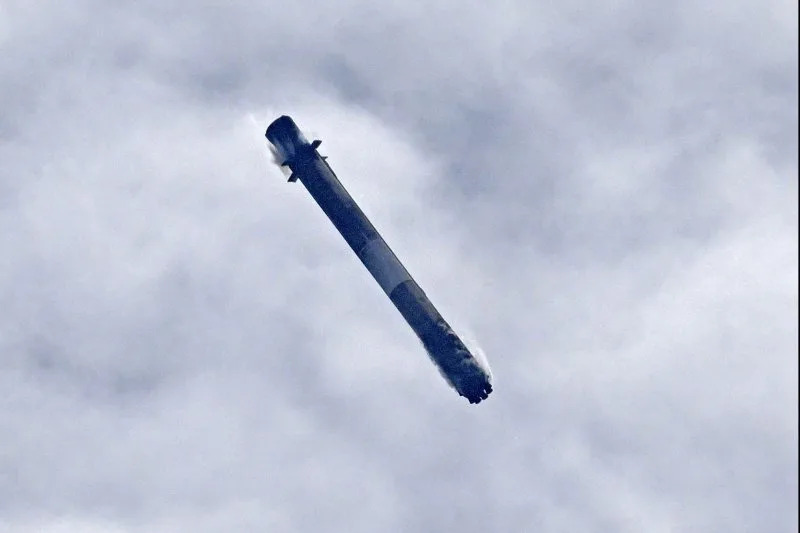
A SpaceX Falcon 9 rocket returns to Landing Zone 1 after launching the Northrop Grumman Cygnus spacecraft for NASA at the Kennedy Space Center, Florida on Sunday, August 4, 2024. Photo by Joe Marino/UPI
Aug. 4 (UPI) -- SpaceX successfully launched a resupply mission for the International Space Station on Sunday after it was postponed Saturday because of unfavorable weather.
The space exploration company used a Falcon 9 rocket to launch the Cygnus spacecraft made by Northrop Grumman -- best known as a defense contractor.
Northrop Grumman changed its launch vehicle for Cygnus missions from its own Antares 230+ rocket to SpaceX's Falcon 9 rocket after the war in Ukraine ended engine and booster production for the Antares program.
Onboard are tests of water recovery technology and a process to produce stem cells in microgravity, studies of the effects of spaceflight on microorganism DNA and liver tissue growth, and live science demonstrations for students, NASA said in a statement.
Shortly before the launch, SpaceX said that the weather was only 35% favorable for liftoff. Yet the rocket took off from Space Launch Complex-40 at the Cape Canaveral Space Force Station in Florida around 11:02 a.m. local time.
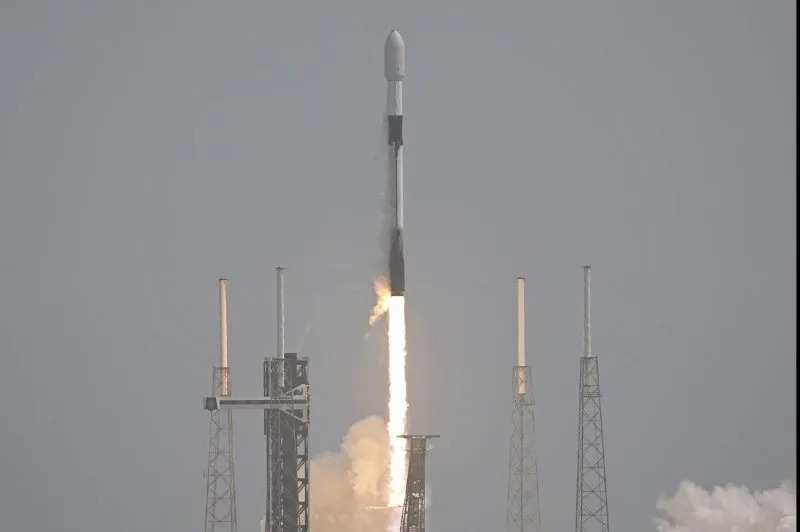
A SpaceX Falcon 9 rocket launches the Northrop Grumman Cygnus spacecraft for NASA on a mission designated as NG-21 to the International Space Station at 11:02 AM from Launch Complex 39A at the Kennedy Space Center, Florida on Sunday, August 4, 2024. Photo by Joe Marino/UPI
About 15 minutes later, the Cygnus spacecraft successfully separated to make its way toward the ISS.
"Next up is solar array deployment, expected in about three hours. These solar arrays help power the spacecraft for its journey to the Space Station," NASA said.

A SpaceX Falcon 9 rocket launches the Northrop Grumman Cygnus spacecraft for NASA on a mission designated as NG-21 to the International Space Station at 11:02 AM from Launch Complex 39A at the Kennedy Space Center, Florida on Sunday, August 4, 2024. Photo by Joe Marino/UPI
The Falcon 9 first stage returned to Landing Zone 1 at Cape Canaveral Space Force Station. This was the 10th flight of the first stage booster supporting this mission, which previously launched Ax-2, Euclid, Ax-3, CRS-30, SES ASTRA 1P, and four Starlink missions.
As for the Cygnus spacecraft, once the cargo haul is unloaded by the ISS crew, it will continue to be used as an extended science lab space for the months it remains docked to the station.
05/08/2024
Polish project astronaut Sławosz Uznański is scheduled to fly to the International Space Station on Axiom Mission 4 (Ax-4).
Axiom Space announced that it is partnering with India, Hungary, and with Poland through ESA to send three national astronauts to the International Space Station on Axiom Mission 4 (Ax-4).
ESA project astronaut Sławosz Uznański has been assigned as mission specialist under the command of Axiom Space’s Chief Astronaut Peggy Whitson.
The other two Ax-4 crew members are pilot Shubhanshu Shukla from India, and mission specialist Tibor Kapu from Hungary. The crew deployment to the International Space Station awaits approval from the Multilateral Crew Operations Panel (MCOP). The MCOP's decisions are reached through a consensus among representatives from all five international space station partners: NASA, ESA, Roscosmos, the Japan Aerospace Exploration Agency, and the Canadian Space Agency.
Ax-4 will be the second commercial human spaceflight mission with an ESA project astronaut. Sponsored by the Polish government and supported by ESA, the Polish Ministry of Economic Development and Technology (MRiT), and the Polish Space Agency (POLSA), this mission includes an ambitious technological and scientific programme. The programme will feature several experiments proposed by the Polish space industry and developed under the lead of ESA.
"ESA is continuing to support its Member States with exploration though commercial access to space. With the upcoming Axiom 4 mission, ESA is working closely with Poland and helping drive forward technological advancements, highlighting Poland's capabilities in space exploration and is a crucial step in advancing its technological expertise,” says ESA’s Director of Human and Robotic Exploration Daniel Neuenschwander.

“ESA continues to embrace the evolving landscape of space exploration, emphasising the importance of commercial ventures in shaping our journey beyond Earth. This mission signifies our ongoing commitment to innovation and collaboration with commercial partners, driving forward new opportunities for growth and scientific advancement,” says Frank De Winne, ESA’s ISS Programme Manager.
A SpaceX Falcon 9 rocket will launch the Ax-4 crew in a SpaceX Dragon spacecraft in Florida. The crew will spend up to 14 days at the Space Station, conducting microgravity research and educational activities after docking with the orbital laboratory.
Sławosz Uznański is currently undergoing an intensive training programme to adapt to the challenges of living and working in space, meeting the rigorous standards for human spaceflight. In August, he will begin training at Axiom Space, NASA, and SpaceX facilities in the US with the rest of the crew.
Follow Sławosz’s journey on ESA’s Exploration blog, X, Facebook, LinkedIn, and Instagram.
HOLLY MEYER
Sun, August 4, 2024
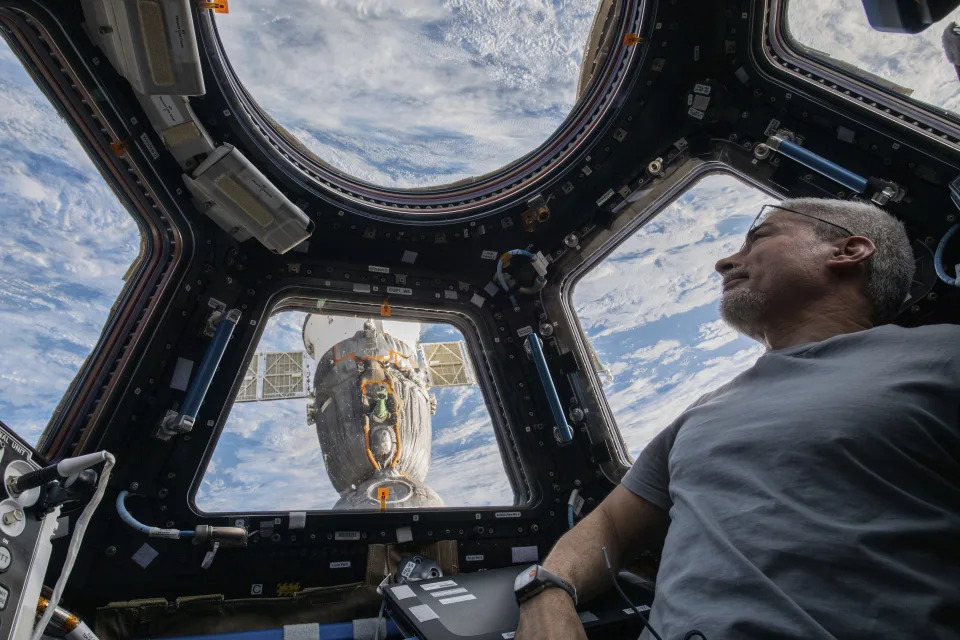
About 10 miles from Johnson Space Center, a Houston-area church takes a moment during Wednesday Bible studies and Sunday evening services to pray for two members who cannot be there.
In fact, there’s no way on Earth for NASA astronauts Barry “Butch” Wilmore and Tracy Dyson to show up at Providence Baptist Church. They’re in space, orbiting the planet. More specifically, these two members are working on the International Space Station together.
Like many astronauts before them, they brought along their faith when they launched into space.
“God uses all of us in pretty neat ways, and I think I get the most joy from what I do thinking about it in those terms,” said Dyson, discussing her job on the “Bible Project” podcast ahead of her March launch on a Russian Soyuz spacecraft.
Dyson's six-month mission isn't scheduled to end until September, but Wilmore and his fellow NASA test pilot, Suni Williams, should have been back weeks ago. They are staying longer than expected following thruster failures and helium leaks on Boeing’s inaugural crew flight for its Starliner capsule. Wilmore and Williams have said they are confident the capsule will return them home safely; engineers are still poring over Starliner test data.
There's no return date yet, which means the congregation’s worries have subsided for now since they are safe aboard the space station, said Tommy Dahn. He is a pastor for the Pasadena, Texas, church where Dyson worships as a newer member and Wilmore is a longtime elder.
It’s the launch and return days that ratchet up their anxieties — and prayers.
“We will definitely be on vigil as we find out when that’s going to happen,” said Dahn, who is in close contact with Wilmore and his wife during the latest mission.
Wilmore paused before boarding the Starliner on each launch attempt, huddling in prayer with technicians and Williams. He acknowledged the risks of spaceflight — especially on a test flight like his.
“Our families have been a part of this from the beginning. ... As far as preparing them, they’re prepared. We trust in sovereign God. Whatever the plan is, we’re ready for it, whatever that might be,” he told reporters ahead of the flight.
Wilmore's faith that God is in control gives his family great peace, his wife, Deanna Wilmore, said via text message. He is content on the space station, neither worrying nor fretting, she said.
“We’re not saying this means that nothing bad will happen or the Starliner will bring Barry home safely, but whatever the Lord does, will be for our good and for His glory," even if they don't fully understand it, she said.
The U.S. space program has had stunning achievements and devastating tragedies.
Former NASA astronaut Mike Hopkins knew space exploration was high-risk, but didn’t feel its full weight until his first assignment. A life insurance company drove that home ahead of his Soyuz rocket launch in September 2013, Hopkins said, recalling being told they didn’t insure astronauts.
Hopkins realized he was not spiritually ready. Between trainings, he began converting to Catholicism, a faith he’d been immersed in since he began dating his Catholic wife but insisted he would never join.
“It’s the idea of being an astronaut and recognizing the risks that we take,” he said. “It felt like something was missing for me.”
When he received Communion for the first time, he was overcome with a clarity and peace that he wanted to take into space. With his priests' help, Hopkins secured permission to take a pyx of consecrated hosts. He administered weekly Communion to himself and on long, intense spacewalk days.
“It just set the tone for the day,” he said. “Then, you just go through the step-by-step process of executing the spacewalk but doing it knowing that Christ is with me.”
Others have taken Communion in space, including Apollo 11 astronaut Buzz Aldrin after landing on the moon with Neil Armstrong in 1969.
The Rev. Wencil Pavlovsky, pastor of St. Paul the Apostle Catholic Church in the Houston area, helped former astronaut Mark Vande Hei bring Communion into orbit. Vande Hei was aboard the space station in 2017 when Pope Francis called it.
Pavlovsky says ministering to astronauts isn’t much different than supporting others: “What I do find unique and what I truly, truly appreciate is that they have a very different perspective because they get to look back at us the way God does.”
Relatedly, there is a phenomenon that philosopher Frank White calls the Overview Effect, when someone’s worldview shifts after looking at Earth from space.
Thirty-six St. Paul the Apostle parishioners have been astronauts, Pavlovsky said. Established in the 1960s to serve the growing space community, the church embraces its history, including with stained-glass windows designed from Hubble Telescope images and its curated collection of space travel memorabilia.
It is unknown how many have practiced their faith in orbit, according to NASA, because some keep it private. But flight-certified religious items are permitted. In 2023, astronaut Jasmin Moghbeli celebrated Hannukah on the space station, sharing a video featuring a menorah, a spinning dreidel and her view of Earth.
Houston Rabbi Shaul Osadchey encouraged a member of his congregation and then astronaut Jeffrey Hoffman to bring the first Torah into space on his final shuttle mission in 1996. Osadchey tracked down a miniature scroll, and he and about 40 synagogue members attended the launch in Florida.
“We bring our culture and our backgrounds with us where we go,” said Osadchey, noting Hoffman read from the Torah, the start of Genesis specifically, on Shabbat. “Jeff brought the Jewish tradition into a new domain — new world that is being conquered by humans.”
The three astronauts aboard Apollo 8 broadcasted their reading from Genesis on Christmas Eve as they flew around the moon, starting with “In the beginning, God created the heaven and the Earth.”
NASA says it helps observant astronauts stay connected to their faith community. Because of Dyson and Wilmore, their Southern Baptist congregation, which numbers around 250 people on any given Sunday, has had unique opportunities.
Despite the distance, women in the church arranged a care package of sorts — notes of encouragement — for Dyson, said Dahn.
“Barry, he ministers to us almost,” he said, noting how Wilmore makes encouraging calls to congregants while in space.
After Wilmore arrived on the space station in early June, he and Dyson appeared live via video at a Providence Baptist Sunday service and gave the congregation a tour of the station, Dahn said. Wilmore taught a lesson before he and others aboard the space station led the congregation in singing “Amazing Grace.”
“It’s kind of thrilling,” said Dahn, adding that thoughts of God come easily when the astronauts show Earth through the space station’s window. Like other theologically conservative Christians, he believes God is the creator of the universe as depicted in the Bible, not the Big Bang or other theories.
“It’s confirming. I don’t want to be crass, but it kind of makes us laugh at the ‘Flat Earthers,'” he said.
Wilmore uses his experience in space to enhance people’s understanding of their Christian beliefs, said Dahn, noting his speaking engagements with the Answers in Genesis ministry, which runs the Creation Museum and Ark Encounter, evangelical attractions in Kentucky.
Few others can do what Dyson and Wilmore do, although they are unlikely to say so themselves, said Corey Johnson, another Providence Baptist pastor. He thinks of how Wilmore organized a group to build a fence at his home, and how Dyson gladly read his sons a book while visiting.
“These are uniquely gifted individuals,” he said, but “there’s more to them than what they do for their day job.”
___
Associated Press religion coverage receives support through the AP’s collaboration with The Conversation US, with funding from Lilly Endowment Inc. The AP is solely responsible for this content.
Emmanuel Urquieta, Baylor College of Medicine
Sat, August 3, 2024

An artist's depiction of two astronauts on Mars. cokada/E+ via Getty Images
Curious Kids is a series for children of all ages. If you have a question you’d like an expert to answer, send it to curiouskidsus@theconversation.com.
What happens if someone dies in space? – Guillermo, Palm Beach, Florida
There’s no question that sending human beings to space is an extraordinarily difficult and perilous proposition.
Since human space exploration began just over 60 years ago, 20 people have died – 14 in the NASA space shuttle tragedies of 1986 and 2003, three cosmonauts during the 1971 Soyuz 11 mission, and three astronauts in the Apollo 1 launch pad fire in 1967.
Given how complicated human spaceflight is, it’s actually remarkable how few people have lost their lives so far. But NASA plans to send a crew to the Moon in 2025 and astronauts to Mars in the next decade. Commercial spaceflight is becoming routine. As space travel becomes more common, so does the possibility that someone might die along the way.
It brings to mind a gloomy but necessary question to ask: If someone dies in space – what happens to the body?
In the future, NASA and other space agencies, along with private industry, hope to establish colonies on Mars. janiecbros/E! via Getty Images
Death on the Moon and Mars
As a space medical doctor who works to find new ways to keep astronauts healthy, I and my team at the Translational Research Institute for Space Health want to make sure space explorers are as healthy as they can be for space missions.
Here is how death in space would be handled today: If someone died on a low-Earth-orbit mission – such as aboard the International Space Station – the crew could return the body to Earth in a capsule within a matter of hours.
If it happened on the Moon, the crew could return home with the body in just a few days. NASA already has detailed protocols in place for such events.
Because of that quick return, it’s likely that preservation of the body would not be NASA’s major concern; instead, the No. 1 priority would be making sure the remaining crew returns safely to Earth.
Things would be different if an astronaut died during the 300 million-mile trip to Mars.
In that scenario, the crew probably wouldn’t be able to turn around and go back. Instead, the body would likely return to Earth along with the crew at the end of the mission, which would be a couple of years later.
In the meantime, the crew would presumably preserve the body in a separate chamber or specialized body bag. The steady temperature and humidity inside the space vehicle would theoretically help preserve the body.
But all those scenarios would apply only if someone died in a pressurized environment, like a space station or a spacecraft.
What would happen if someone stepped outside into space without the protection of a spacesuit?
The astronaut would die almost instantly. The loss of pressure and the exposure to the vacuum of space would make it impossible for the astronaut to breathe, and blood and other body fluids would boil.
What would happen if an astronaut stepped out onto the Moon or Mars without a spacesuit?
The Moon has nearly no atmosphere – a very tiny amount. Mars has a very thin atmosphere, and almost no oxygen. So the result would be about the same as exposure to open space: suffocation and boiling blood.
What about burial?
Suppose the astronaut died after landing, while on the surface of Mars.
Cremation isn’t desirable; it requires too much energy that the surviving crew needs for other purposes. And burial isn’t a good idea, either. Bacteria and other organisms from the body could contaminate the Martian surface. Instead, the crew would likely preserve the body in a specialized body bag until it could be returned to Earth.
There are still many unknowns about how explorers would deal with a death. It’s not just the question of what to do with the body. Helping the crew deal with the loss, and helping the grieving families back on Earth, are just as important as handling the remains of the person who died. But to truly colonize other worlds – whether the Moon, Mars or a planet outside our solar system – this grim scenario will require planning and protocols.
Hello, curious kids! Do you have a question you’d like an expert to answer? Ask an adult to send your question to CuriousKidsUS@theconversation.com. Please tell us your name, age and the city where you live.
And since curiosity has no age limit – adults, let us know what you’re wondering, too. We won’t be able to answer every question, but we will do our best.
This article is republished from The Conversation, a nonprofit, independent news organization bringing you facts and trustworthy analysis to help you make sense of our complex world. It was written by: Emmanuel Urquieta, Baylor College of Medicine
Read more:
Emmanuel Urquieta is supported by the Translational Research Institute for Space Health.




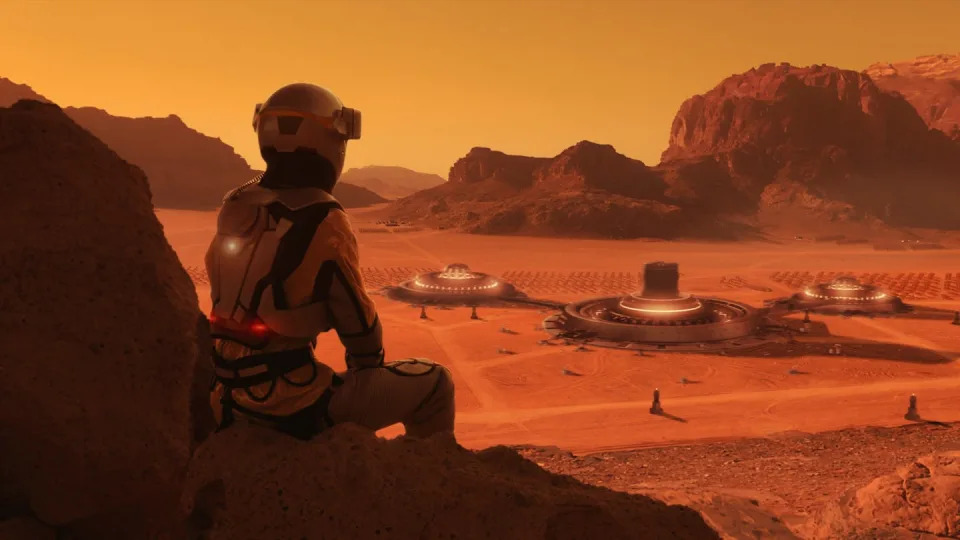
No comments:
Post a Comment